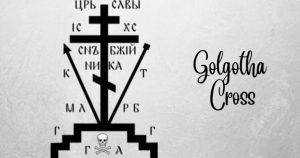[ad_1]
Even if you’re not a practicing Christian, the religion of Jesus Christ and his disciples has spread so far and wide—especially in the West and around the English-speaking world—that it’s nearly impossible not to know its meaning as a religious symbol. Meant to memorialize Jesus’ persecution and the power of his faith and belief in God, the Christian cross is a powerful symbol recognized worldwide by practitioners and atheists alike.
But the basic Christian cross is far from the only cross that is used in religious ceremonies and symbolism across the world. There are actually plenty of other crosses that are designed differently, used in different ways, and full of disparate symbolism, too. In this list, we’ll take a look at ten lesser-known religious crosses and explore their meanings and purposes for the people who find meaning, hope, faith, and power within them.
Related: 10 Religious Beliefs That Have Changed with History
10 The Golgotha Cross

The Golgotha cross looks like a pretty random and disorienting design, but it has a lot of symbolism tied up within it. And it’s a significant image representing true forgiveness—with meaning on multiple scales. For one, its design is somewhat similar to the Greek Orthodox cross, especially in its top half. There is a lot more going on in the design than just the tenets of the Greek Orthodox belief system, though. For one, the Golgotha cross features another line above the cross’s head to differentiate it.
But that’s only the beginning of the meanings within the Golgotha cross. At the left side of the cross, we can see the Lance of Longinus pointing diagonally upward. On the other side, there is a design meant to signify a sponge that’s been stabbed through the end of a long stick, which is intended to represent the vinegar Christ was given to drink while he was being crucified.
Most strikingly, at the bottom of the cross, we find a skull. That skull is there to indicate the site on Mount Golgotha where Christ was crucified and passed prior to resurrection. There is often an inscription within the cross design as well. Written in several different languages within its various forms, the inscription notes that Jesus has become King, and Golgotha is no longer a place of death but a place of paradise within the faith. Lots of very, very deep meaning comes within this remarkably complicated cross![1]
9 The Papal Cross

As the name suggests, the papal cross is the official symbol of the pope. The leader of the Roman Catholic order worldwide is the only one who is allowed to use it, as the cross indicates his authority over Catholicism and deference to God. The cross is meant to signify that the pope is the highest and most important religious leader on Earth, serving below God and connecting millions across the world to Jesus Christ, his faith, his works, and his disciples. Historically, the papal cross was first given to the Knights Templar. They then carried it through battle on their way to the Crusades. So it has been a historically significant design for many Christians throughout the years.
As far as the design goes, the papal cross is really pretty simple. It is just like the regular Latin cross, except it has three horizontal lines going across from the top in increasing lengths instead of just one horizontal design. The three lines represent two things. Most notably, they are representations of the Father, the Son, and the Holy Spirit—the Holy Trinity, as we all (likely) know. Beyond that, they are said to represent the three dominions of the Pope himself: up in Heaven, down on Earth, and within the Church.[2]
8 The Scandinavian Cross
Take a look at the flags of Denmark, Iceland, Sweden, Norway, Finland, and the Faroe Islands. What do all those marks have in common? If you turn all the flags on their far right side, you turn up a Latin cross standing upward! So, with the flags horizontal, every single one of them has a Latin cross turned to the side—with the actual cross always closer to the point at which the flag will be hoisted. As you might suspect by the fact that we are writing about it now, this is very much NOT a coincidence! Known as the Nordic cross, these flag symbols are meant to represent the very long and proud histories these countries have as Christian nations.
The origins of this Scandinavian or Nordic cross can be traced back to Denmark. It was first used there centuries ago. At the time, Christianity was rising quickly in Denmark. However, it had to compete with the popularity of various Norse and Viking religions—which the Christians saw as heathen practices. Soon enough, though, Christianity swept across Denmark.
To prove their allegiance to this newly-gained religion, leaders there used the cross on their flag. Sweden then followed suit with their own flag as Christianity swept across that land, too, and from then on, Norway and the rest joined up. Centuries later, the Scandinavian cross remains a thing. And a very prominent flag fixture![3]
7 The Chi Rho Cross
The Chi Rho cross is also sometimes known as Constantine’s Cross or even “the Chrismon.” In religious and related iconography, Christograms are what happens when letters form an abbreviation for the name of Jesus Christ. And the Chi Rho cross is actually one of the oldest and first-created Christograms ever. See, “chi” and “rho” are Greek letters that are used to spell the word “Christos.” The ancient Roman emperor Constantine thought those letters held significant emotional and religious value for his military. So he created a cross with their designs done upon them.
In his beliefs at the time in the 4th century AD, Constantine felt that having “chi” and “rho” as part of a special cross adorning his men’s battle gear and flags would ensure they were protected and saved during battles with their enemies. God would grant Constantine and his men grace because they showed such fervent faith while fighting, and they would be able to come out of vicious wars unscathed.
Throughout the centuries, Constantine’s cross has developed to include a circle around it, too, which is usually exemplified by a wreath. In sum, now, the Chi Rho cross is meant to symbolize Jesus Christ’s own victory over battle—the battle of his persecution, death, and subsequent resurrection.[4]
6 The Tau Cross
The Chi Rho cross isn’t the only Christogram out there dealing with religious iconography like this. In fact, the Tau cross is another really significant Christogram in this same vein. This cross (obviously) takes its inspiration from the Greek letter “tau,” after which it is named. And its religious inspiration comes from the Old Testament of the Bible—so there are some seriously apocalyptic and end-times-related underpinnings to the whole deal here.
Some historians today think the Tau cross was the type of cross upon which Jesus Christ was actually crucified. So, historically, perhaps it’s the most accurate of all the crosses in that way. The Greek letter “tau” takes on a deeper meaning in the Book of Ezekiel, though, where the Tau was supposedly a sign placed directly on the foreheads of God’s chosen ones—or people whom He wished would be saved.
In more modern faith practice, both St. Francis and St. Anthony are closely related to the Tau cross. The Franciscan Order even uses it as their symbol because of St. Francis’s connection. And it is still held dearly by many adherents who hope to be among God’s chosen people.[5]
5 The Ankh Cross
As you can see by looking at it, the Ankh is a cross with a circle on top. Pretty simple, right? Its use and meaning are pretty simple, too—but pretty powerful as well. Egyptian artists and religious adherents have used the Ankh for centuries to symbolize life. It was common to see the Ankh being held or offered to the people by gods and goddesses in Egyptian artwork throughout history (and yes, that includes pharaohs).
Basically, the Ankh began as a thing that the Coptic Orthodox Church used as a religious symbol. Ages ago, before Arabian peoples conquered Egypt and the religion of Islam swept across the land, many Egyptians were Christians. They called themselves “Copts” and worshiped Jesus in large numbers prior to the spread of Islam after the 7th century AD.
After Islam spread across Egypt, “Copts” became a word synonymous with the few Egyptians who remained Christian. Today, Coptic Christians in Egypt worship Jesus just like there were hundreds and hundreds of years ago. Those people, then, recognize the Ankh as a cross that honors life and promotes humanity, eternal life, immortality, and even reincarnation.[6]
4 The Coptic Cross
Now that you’ve learned all about the Ankh, let’s get you thinking about a second—and very different—cross used by Coptic Christians in Egypt. Sensibly called the Coptic cross, this design is tied closely with the Coptic Orthodox Church in Cairo, Alexandria, and other places in Egypt where that nation’s nearly ten million Coptic Christians practice their faith. It is NOT the same as the Ankh, and it is not to be seen as interchangeable with the Ankh, either. Even though both crosses are used by Coptic believers to signal their faith and honor their religious tenets! And in the modern age, Coptic crosses have become very, very popular tattoos often done on people’s wrists in Egypt and throughout the Coptic world!
Historians believe the Coptic cross was actually created with the Ankh in mind. Of course, it’s more intricate and ornate than the Ankh. And it doesn’t have a circle at any point at the top of the cross, though there is one that sits inside the center, with the four points of the cross pushing outward from there.
The Coptic cross is also commonly known as the “Crux Ansata.” So, if you see that name out there anywhere, they’re talking about this same design. As far as symbolism goes, the Coptic cross is said to honor the Passion of Christ—and specifically his resurrection after being crucified and killed.[7]
3 The Sun Cross
Unlike many other crosses on this list, the sun cross was originally meant for purposes entirely outside those of Christianity and Christian-related symbolism. It originally began as a symbol used across Bronze Age Europe—or even before that.
In turn, it was an important pagan sign that was said to represent the sun. The meaning was deeper than just that, though, with the circular shape of the cross’s outer wheel supposedly representing the birth of, well, the wheel. The wheel aided mankind and advanced civilization in ways untold centuries before, and the sun cross was designed to symbolize those developments.
After hundreds of years of those meanings, the sun cross’s purpose evolved. By the time of ancient kings, the wheel was said to represent the all-encompassing power of those rulers in the worlds they controlled. Alchemists even used the sun cross as their representation of copper alloy in some instances within ancient kingdoms.
And the sun cross continues to live on today. Astrologists, Wiccans, and other non-Christian believers use it to represent the all-encompassing aspects of nature and the earth. Christians use it, too; they claim the sun cross’s circle represents an angel’s halo. Those angels, these believers claim, help guide people’s choices and make them safe in their decisions.[8]
2 The Lithuanian Cross

The Lithuanian cross, also known as the “Vyties cross,” has quite the history in the Baltic area of Eastern Europe. It is a double cross that was originally used as a symbol by King Jogalia of Poland way back in the late 14th century. For Jogalia, the double cross was a personal insignia meant for his rule, his military, and his power.
In time, after he died, King Jogalia’s brothers and descendants continued the tradition of the double cross. They used it as the family insignia and pushed it forward into the Jogalian Dynasty that came after the king’s rule. Symbolism was meant to show how King Jogalia had converted successfully to Christianity and later encouraged all his followers, subjects, and descendants to do the same.
In more recent centuries, the double cross, as Jogalia knew it, has come to stand for the nation of Lithuania. The small eastern European nation of Lithuania is said to be the land of crosses, for these symbols are parts of the iconography and aesthetics all over the tiny nation. But the cross as a political symbol goes back to the early 20th century.
It was then that Lithuania was able to wriggle free from the control of other powers in the area (before the Soviet Union became a thing, of course). The double cross came to represent the powerful branches of the Lithuanian government. Public figures, politicians, and military members alike all used the cross with pride to show their Lithuanian heritage. It saw a resurgence in popularity after 1991, too, when Lithuania was freed from the collapse of the Soviet Union.[9]
1 The Indian Swastika
Of course, we all know the Nazi swastika that was used as a symbol by Adolf Hitler during his rise to power in Germany in the 20th century. But interestingly, the Nazi symbol is not the only swastika out there that is used by faith followers. Thankfully, the Indian version of this same swastika is a lot more wholesome in its meaning—even though it has unfortunately been rendered somewhat unusable in the modern era because it is so often associated with Hitler’s regime and its after-effects.
In ancient Sanskrit, “swastika” is a word that means “conducive to or good for well-being.” It was a word that had very good connotations in the Sanskrit language and its associated societies throughout history. It meant good omens were coming, and it became closely related to the symbol of the “Fylfot,” which was a leftward-facing swastika more commonly known as the “sauwastika.” That should be differentiated, then, from Hitler’s Nazi swastika, which faces rightward in the cross’s turns. It’s also turned on an angle in more of a diamond shape.
As for the Indian swastika itself, in more recent centuries, the symbol has been adopted by Buddhist practitioners. On occasion, those from other religions have adopted it for their use and meaning, as well. For a long time, then, it seemed the swastika was going to be used as a much-loved symbol for people from all over the world, mostly among South and East Asian religious sects.
Hitler’s co-opted use of the symbol has mostly ruined those good vibes, though—especially in Europe and the West. Even though it did nothing to deserve the wrath it gets, the Indian swastika is unfairly associated with what the Nazis used in their rise to power in post-World War I Germany.[10]
[ad_2]
Source link

Comments are closed.